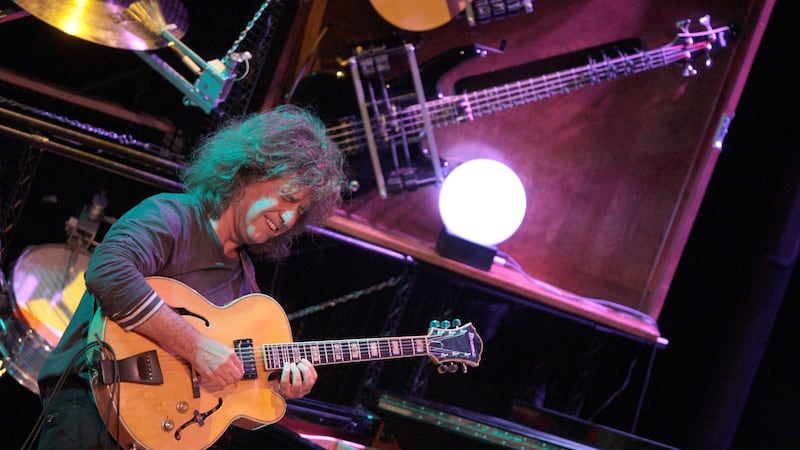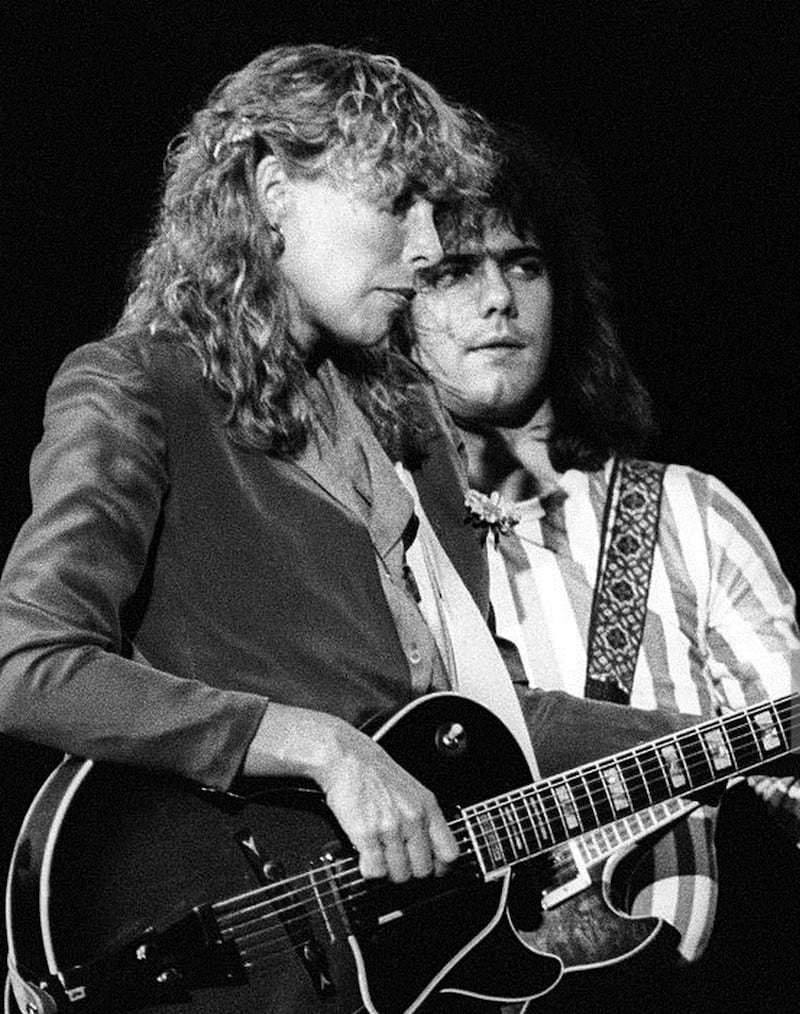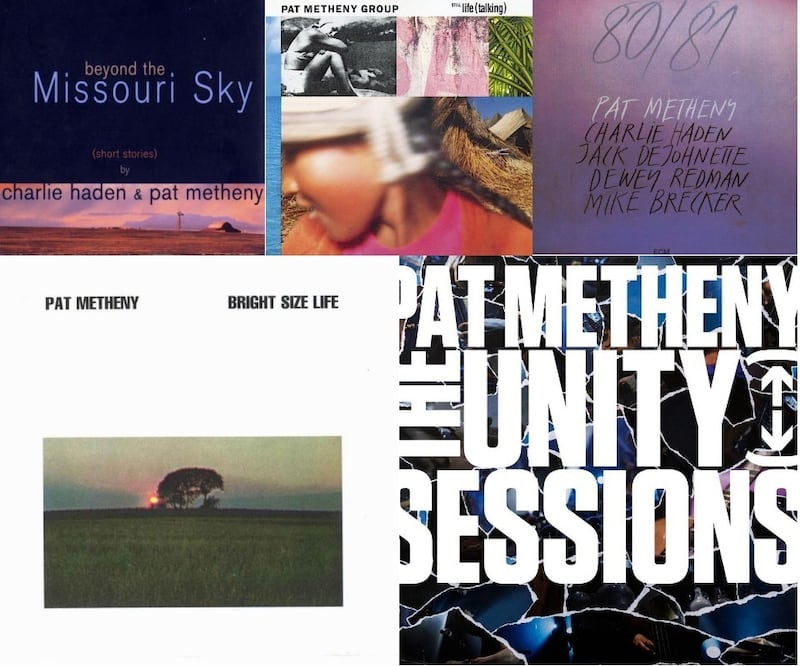A lawyer's boardroom in midtown Manhattan is not exactly the sort of place you expect to find a jazz musician, but the man I am waiting to meet is no ordinary jazz musician. Pat Metheny is one of maybe only half a dozen improvisers in the world who is properly famous, a virtuoso and an innovator, hugely respected by his fellow musicians but, unlike most of them, massively popular with the sort of people who wouldn't know jazz if they found it in their breakfast cereal.
Not that you would guess any of this from the defiantly casual form that bounds into the room, right on time. Dressed in faded denims and a black and white shirt, clutching a half-drunk bottle of Coke and, at 63, still sporting his trademark mane of unruly hair, Metheny looks like just another guitar nerd. The shelf-ful of Grammys, the stratospheric record sales and the globe-trotting career may suggest otherwise, but the immediate impression is of a guy who is trying hard to be normal.
Patrick Bruce Metheny was born in 1954 in Lee's Summit, Missouri, a small Midwestern town a few miles outside Kansas City, where his father owned a car dealership. The family were musical, with his grandfather, his father and his older brother all playing trumpet to a high level, and Metheny remembers hearing three generations practising in the basement. "As far back as I remember, it was all about practice."

Curiously, for a town that was on the fringes of the Ozarks, a region rich in country and bluegrass music, the guitar was never really on the horizon in the Metheny household, and when young Patrick first expressed an interest in that instrument, it was not greeted with much enthusiasm.
“The political and cultural meaning of what ‘guitar’ specifically was in Lee’s Summit, Missouri” – he pronounces it “Miz-oor-ah” – “in 1965 and ’66 was something that a parent would want their kid not to be doing,” he says deliberately. “I mean, the Sixties were happening everywhere else but they didn’t start in Missouri until 1971.”
So where did the interest in the guitar come from?
"Like a million other people," he intones, almost apologetically, "it was The Beatles on The Ed Sullivan Show. That was a galvanising moment. To me the guitar went from being an instrument to being an iconic representation of something that was just about to happen. And it did!
"At first it manifested itself for me in the classic holding a broom and pretending. And then our neighbours' father was one of these bluegrass guys and they told me, 'He's got an electric guitar.' Now, I had never seen an electric guitar in person, and I was like, 'We have to look at it.' And they were like, 'No, you can't even look at it.' It was like Spinal Tap, right? So one day when he wasn't around, we looked at it, and I was like, 'What do you do? Do you plug it into the wall? It's an electric guitar, right?'"
A jazz thing
On his 12th birthday, his parents allowed him to buy one of these wondrous objects for himself and the die was cast. But if the choice of instrument was made, the direction in music came a year or so later when his brother Mike arrived home with a copy of Miles Davis's Four & More.
"In five seconds my life changed. From that moment on, I was worse than the worst jazz snob. I just wanted to listen to Miles and Sonny Rollins and 'Trane and Wes Montgomery. I wanted to know what that was. And I still want to know what that is."
By the time he was 15, he was sitting in with older jazz musicians on the Kansas city scene, doing crowd-pleasing imitations of his favourite guitarist, Wes Montgomery.
“He was my earliest, strongest influence, and still my favourite guitar player, and man, the first year or two that I played, people would go kind of crazy live because I was just a kid and I could sound like Wes.”
Wes is more
But if audiences were impressed, his fellow musicians were less so, and he remembers clearly the moment when he realised what being a jazz musician was all about.
"There was a little bit of a vibe on the bandstand one day from a guy in town, a good player, and he said, 'Hey man, what are you doing Wes's thing for?' And I was like 'Yeah, I love Wes so much, why would I do that? I don't want to do what Wes did, I want to do what Wes did!'"
So began a journey that has taken the young Midwesterner from imitator to innovator. A teenage prodigy, and the youngest tutor at Berklee College of Music in Boston, he seemed to emerge fully formed on his debut recording, Bright Size Life, with a warm, melodic sound that was redolent of the history of the music but pointing in a brighter, more inclusive direction.

"I can still play the music from Bright Size Life right now," he says proudly, "and those arguments still make sense to me. I've really worked hard to maintain that standard."
Metheny’s work rate has indeed been prodigious. Since the mid-1970s, he has kept up a punishing touring schedule, frequently playing more than 200 gigs a year, and recording a shelfload of albums along the way, recordings which reveal a restless musical curiosity.
The Pat Metheny Group, his principle vehicle for much of the last 40 years, blended jazz with rock and Brazilian pop among much else and made him a household name far beyond the narrow confines of the jazz scene. But alongside the PMG, he has always maintained an active presence in the jazz community, leading his own influential trios and collaborating with artists such as Joni Mitchell and Brad Mehldau.
Orchestral manoeuvres
He was one of the first musicians to explore the potential of computers, and pioneered the use of the guitar synthesiser. Among the albums, alongside the bestsellers and the string of Grammys, there are outliers exploring free jazz and minimalism, solo acoustic albums, and even an album featuring his own automatic orchestra.
So, having scaled such heights, how does he stay fresh and moving forward?
“To me, I understand there is a certain, um . . . ‘dilemma’ is not the right word . . . ‘reality’, after you’ve written 500 or so tunes, and you’ve made 40-something records, and you’ve played a thousand gigs: the idea is to understand that you need to go beyond all that.”
I guess it's my delayed midlife crisis, which kicked in about three or four years ago. Suddenly guitars were cool
“It’s like the currency that I’m trading in is that, it’s not a currency of ‘do people like this?’ or ‘how many is it going to sell?’ or ‘does so-and-so think this is good?’. I mean, I don’t want to sound snotty and say ‘I don’t care’, but my focus is on ‘it’, it’s not on what’s around it, it’s on ‘it’.”
Contrary to expectations, and despite a clearly voracious appetite for experimentation, he claims never to have been much interested in the guitar per se.
“No,” he protests, “I never really cared about guitars. Guitars were like screwdrivers to me. It’s just a piece of wood with strings on it, it’s a tool.”
That all began to change when his neighbours from Lee's Summit got in touch a few years ago and told him they were selling their father's old guitar, the very one they had all looked at without permission back in the 1960s. So now that splendid Gretsch Chet Atkins 6120 is hanging on his wall at home, along with a few other rare instruments.
“I guess it’s my delayed midlife crisis,” Metheny says, laughing, “which kicked in about three or four years ago. Suddenly guitars were cool. I got very interested in particularly pre-war Gibsons, the Charlie Christian-era guitars, and I have a couple now that are really significant, that I do play, but actually I just kind of look at them too,” he adds bashfully. “And that’s new territory for me.”
Five essential Pat Metheny albums

Bright Size Life (1976): Metheny's astonishing debut, which also featured emerging bassist Jaco Pastorius, signalled a new direction for jazz guitar.
80/81 (1980): The guitarist assembled a stellar cast for this towering, expansive double album, including bassist Charlie Haden, a fellow Missourian who would become his lifelong friend.
Still Life (Talking) (1987): Lush, harmonically and rhythmically sophisticated music that is deceptively poppy. But when the guitar solos start . . .
Beyond the Missouri Sky (1997): A sublime duo with his old friend Charlie Haden, delving into their shared roots in folk and country music.
The Unity Sessions (2016): Recorded live (and simultaneously filmed) after a long tour, here's Metheny's current Unity group in full and glorious flight.
- Perspectives: An Evening With Pat Metheny is at the NCH, Monday, November 13th, and the Waterfront, Belfast, on Tuesday, November 14th












